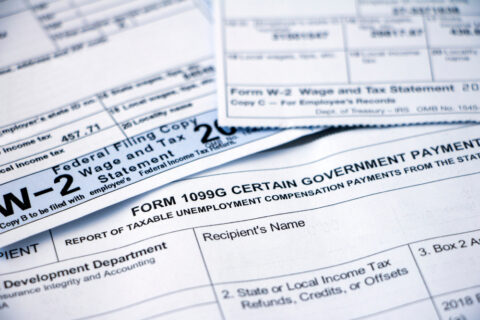Do you make charitable contributions? If so, read on.
We may be able to help you cut the costs of charitable giving – or increase the size of your contributions without costing any more in after-tax dollars – in part due to the new Tax Cuts and Jobs Act of 2017 (“TCJA”). Taking action before yearend could mean a quick return on your efforts.
In this short presentation, we summarize three strategies that can be used to increase your charitable giving “bang for the buck”:
- Bunching – the “Triple Play”
- Giving Appreciated Securities
- Qualified Charitable Distributions
1. Bunching – the “Triple Play”
The TCJA enacted a larger standard deduction – in 2018, $12,000 for individuals, $18,000 for heads of households, and $24,000 for married couples filing jointly and surviving spouses. For 2018, taxpayers over 65 years of age get an additional standard deduction of $1,300 ($2,600 for married seniors filing jointly). The TCJA also reduces the types and/or amounts of deductions that can be claimed as itemized deductions. For many people, the only itemized deductions available will be state and local taxes (SALT) (limited to $10,000 per year) and charitable contributions. Bunching involves making more than one year’s charitable contributions in a single year. It appears that, for many people, the more years’ contributions that you can bunch into a single year, the more are your tax savings. The “Triple Play” calls for making three years’ contributions in a single year, say 2018. There’s no secret formula for three years, versus two years or versus more years. However, in choosing a bunching period, one might take into account the number of years beyond 2018 (2019 and 2020) that Washington will probably be gridlocked and the income tax laws are probably less likely to change.
The benefits of the Triple Play will vary by taxpayer. However, we took a simple example and measured the tax benefits. We used a three-year period. We calculated tax effects using the top marginal tax rate of 37%. We used SALT deductions of $10,000 and charitable contributions of $20,000 per year. By bunching three years of contributions (totaling $60,000) into year one, we calculated tax savings of over $10,000, versus making those contributions annually. The actual savings will vary, according to a taxpayer’s individual situation.
There are practical issues that might affect your willingness to prepay three years of charitable contributions, assuming that you have the money available to do so. One such issue is that the beneficiary(ies) of your largess may change over time. A number of our clients are using Donor Advised Funds (DAFs) in order to be able to manage their giving over time. One contributes cash, securities or other assets to a DAF at a public charity and, generally, claims the deduction in the year of the contribution to the DAF. The donor can recommend to the public charity grants from his/her DAF to virtually any IRS-qualified public charity. Many public charities have DAFs.
2. Giving Appreciated Securities
Either separately or in conjunction with a Triple Play, you can benefit from the time-tested strategy of contributing appreciated publicly-traded securities that you have held for more than one year. (You can use some other assets held more than one year; the rules can get more complex.) The actual benefits vary by taxpayer. However, in a sample test that we performed, we assumed that a taxpayer held stock more than one year and that the stock had appreciated 40 percent (along with a few other normative assumptions). The benefit of donating the stock approached 10 percent, compared to the amounts needed to satisfy the same dollar contribution with after-tax proceeds of selling the stock.
3. Qualified Charitable Distributions
I can state from personal experience that some things about growing older are not delightful. However, turning 70 ½ years of age can bring some welcome tax relief. Most people must start to take required minimum distributions (RMDs) from their tax-deferred retirement accounts, including IRAs, by April 1 following the year in which they turn 70 ½ years of age. In and of itself, this does not rise to the classification of tax relief, does it?
However, when one turns 70 ½, one also can direct the trustee of his/her IRA to make contributions directly to qualified charities, in the amount of up to $100,000 per year per taxpayer (that could be up to $200,000 for a married couple filing jointly and both spouses maxing out their amounts). (Note: donor-advised funds, most private foundations, and certain other grant-making organizations are not “qualified charities.”) While this qualified charitable distribution (QCD) is not deductible, the QCD is not included in the taxpayer’s income either. Also, the QCD counts toward one’s RMD.
Assume the same facts above as those in our Triple Play example. If one directs QCDs from an IRA to the charities rather than make charitable contributions to those charities, the result is about 80% better than the very good results in the Triple Play. Also, you don’t have to bunch your charitable contributions to get the QCD results.
Next Steps?
While many people will benefit from one or more of these strategies, the results vary depending on individual situations. Contact your HM&M tax advisor – We’ll help you choose a way to boost your tax savings through your charitable giving.
Latest News
On June 9, the IRS released Announcement 2022-13, which modifies Notice 2022-3, by revising the optional standard mileage ...
At the tail end of 2021, the Internal Revenue Service (IRS) released new Schedules K-2 and K-3 effective ...
This information is current as of Sunday, November 21, 2021. On Friday, November 19, 2021, after the Congressional ...
HM&M Updates
DALLAS, Dec. 11, 2024 – Springline Advisory, a trailblazing financial and business advisory firm, is proud to announce its partnership ...
Last month, Senior Manager, Pearl Balsara was invited to speak at the 2023 FPA DFW Annual Conference in ...
We are pleased to announce the winners of the 2022 HM&M Excellence Awards. Ronna Beemer, Keith Phillips, and ...









